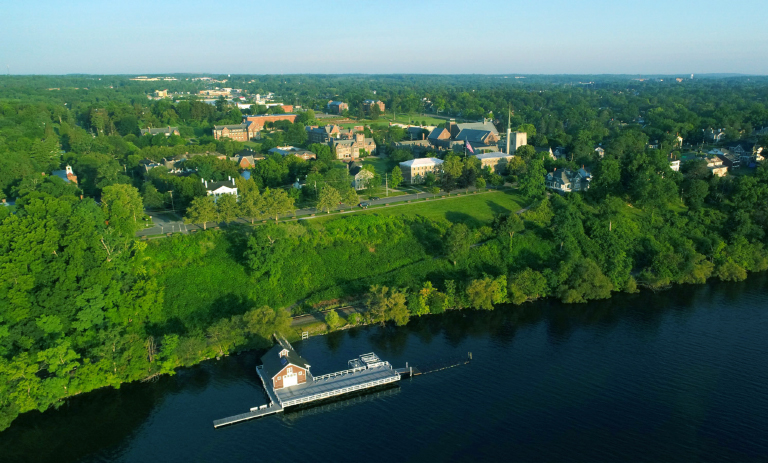
Lives of Consequence
John P. Grotzinger '79, Sc.D.'13

Mission Leader and Project Scientist, Mars Science Laboratory
As the mission leader and project scientist for the Mars Science Laboratory, John P. Grotzinger ’79, Sc.D. ’13 guided the team that landed NASA’s Curiosity rover, discovering organic molecules and evidence of an ancient Martian lake, and made history when he confirmed the presence of an environment that could have supported microbial life.
Continuing his involvement with the NASA mission, Grotzinger currently serves as the Fletcher Jones Professor of Geology at the California Institute of Technology, where he also is the Ted and Ginger Jenkins Leadership Chair for the Division of Geological and Planetary Sciences. An eminent geologist with wide-ranging interests in sedimentary processes, geobiology, and Earth’s early history, Grotzinger has been elected into the National Academy of Sciences, one of the highest honors that can be accorded a U.S. scientist.
Regarding the Curiosity mission’s discoveries on Mars, Grotzinger was quoted in a 2014 New York Times article detailing the findings of methane and carbon-based organic molecules on the red planet. While the methane might be a geological product, the article stated, it might also be “the waste product of certain living microbes,” which, Grotzinger says, “is one of the few hypotheses that we can propose that we must consider as we go forward…In part, Curiosity was built to explore for organics, and we found them.”
Grotzinger has received a multitude of awards throughout his career, including the National Science Foundation Young Investigator Award, the Fred Donath Medal from the Geological Society of America, the Henno Martin Medal from the Geological Society of Namibia and the Charles Doolittle Walcott Medal by the National Academy of Sciences. He was the recipient of the 2011 Laurence L. Sloss Award from the Geological Society of America for his original and lasting contributions to sedimentary geology. He was also awarded NASA’s Outstanding Public Leadership Medal in recognition of the Curiosity rover mission's success, and his work on that project led Popular Mechanics to list him among its 10 Innovators Who Changed the World in 2013. In 2019, he was elected to the American Academy of Arts and Sciences, one of the county’s oldest honorary societies.
A former professor at the Massachusetts Institute of Technology (MIT), Grotzinger was appointed Waldemar Lingren Distinguished Scholar by MIT in 1998 and Robert E. Shrock Professor of Earth Sciences in 2001. As a director of the Earth Resources Laboratory at MIT, he researched and investigated the spontaneous burst of life that spawned the early ancestors of all animals, otherwise known as the Cambrian Explosion, which remains one of the most debated and mysterious topics in evolutionary biology. An early 1990s discovery of a fossil in Namibia by Grotzinger has led scientists to redefine the time frame of animal and human evolution. In 2001, Grotzinger traveled to Oman to find fossils and geologic evidence to support his theory on the reclassification of the time periods. He and his team found that the Cambrian Explosion may have been the result of a mammoth environmental event in which even the oceans became anoxic.
A spinoff of Grotzinger's work in the Cambrian and Precambrian eras has applications to the petroleum industry. Using Grotzinger's groundbreaking techniques, scientists are now better able to determine the location of oil and gas reserves in rocks and sediments of old age, which had been previously regarded as uneconomic. He also applied his theories of evolution to the study of Mars and developed digital mapping techniques that allow him and his colleagues to study Martian geology for signs of life.
He was one of only 28 scientists chosen by NASA to participate in the 2003 Mars Exploration Rover Mission, during which he performed an analysis of Martian sediments and sedimentary rocks and assessed the role of liquid water in shaping Martian landforms.
In 2004, Grotzinger served as a member of both the geology and long term planning groups for the Mars Exploration Rover mission. As a member of the geology group, he worked on analysis of image data trying to look for distinct textures and fabrics in the soil and rocks which might suggest water as an agent in their formation. As a member and leader of the long term planning group, he helped develop a context for discussion of science strategies that extend beyond day-to-day discoveries.
In a 2013 profile in The New Yorker, Burkhard Bilger contextualizes the scope of Grotzinger's work as nothing less than the dawn of a new era in planetary exploration, describing Grotzinger as: "Now fifty-five, Grotzinger has worked in Siberia, Namibia, Oman, and Arctic Canada, among other locations. He has rafted rivers in Yakutsk, dodged grizzly bears and black flies around Great Slave Lake (his record for fly bites is two hundred in a single night), and scouted rock formations on the Skeleton Coast, sometimes hiking more than twenty miles a day. The long months of solitude and open sky have given him a lean, wind-bitten look and a laconic style rare among NASA's high-strung engineers. Watching him at work, in the days leading up to the landing, I was reminded of Henry Fonda in one of his early Westerns: squinting at the horizon and chewing over his options while the townsfolk galloped off in a dozen different directions.”
At Hobart, Grotzinger received a bachelor’s degree in geosciences. He and went on to earn an M.S. from the University of Montana in 1981 and a Ph.D. from Virginia Polytechnic Institute and State University in 1985. He completed his post-doctoral work at Columbia University from 1985 to 1987.
On May 19, 2013, Hobart and William Smith Colleges presented him with an honorary Doctor of Science during Commencement.
